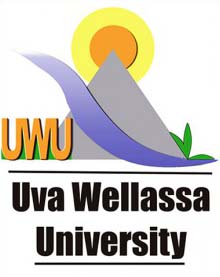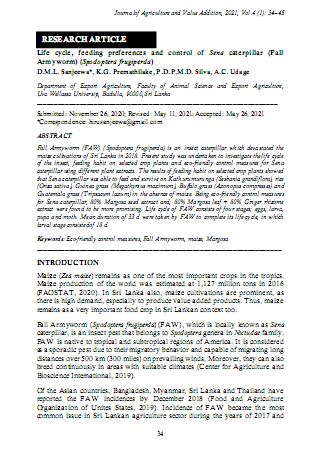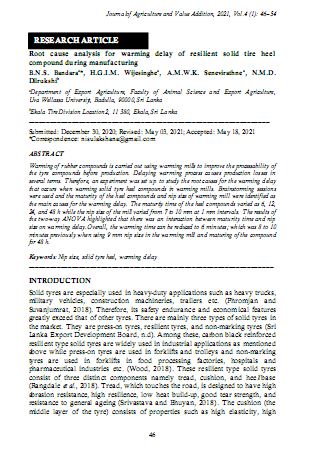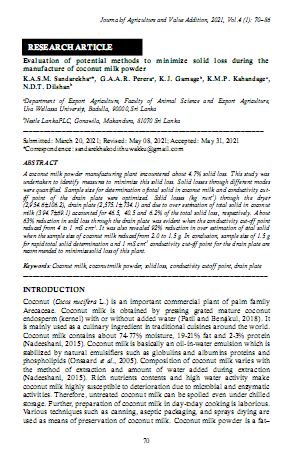
Volume 05 Issue 01
RESEARCH ARTICLES
01. Study of the best washing cycle for processing of surimi from spotted sardinella (Amblygaster sirm): A preliminary study
M.K.C. Priyadarshanaa* and C.N. Walpitaa
a Department of Livestock Production, Faculty of Agricultural Sciences, Sabaragamuwa University of Sri Lanka, Belihuloya,70140, Sri Lanka
INFORMATION
Journal Title: Journal of Agriculture and Value Addition
Volume : 5 Issue 01
Page : 1- 15
Submitted: February 15, 2022; Revised: May 31, 2022; Accepted: June 07, 2022
* Correspondence: kasunc@agri.sab.ac.lk
ABSTRACT
Amblygaster sirm is an abundant small pelagic fish species that can be used as an alternative ingredient for the processing of surimi. However, due to a lack of knowledge regarding the preparation of surimi from Amblygaster sirm, it is not yet used as a potent raw material in the processing of surimi. Therefore, this study aimed to investigate the effect of washing on the physico-chemical properties of Amblygaster sirm fish muscles and the processing of surimi thereby. Collected fish samples were analyzed for myoglobin content along with the number of washing cycles. Surimi was made out of the treatment that gave the lowest myoglobin content and was analyzed for the sensory attributes i.e., aroma, color, flavor, juiciness, tenderness and overall acceptability. As per the results, double washing showed the most extensive loss in myoglobin content and fat content (P<0.05) as well. Protein contents differed significantly (P<0.05) between treatments. Accordingly, double washing was the best number of washings that produced the best quality surimi with a least number of washing cycles leading to low wastewater and labor. However, the sensory evaluation results indicated that the overall acceptability of the product behaved at an average governed by the people’s perceptions regarding surimi.
Keywords: Myoglobin, Surimi, Washed mince, Washing cycle
02. Assessment of marker genotypes associated with the resistant genes in a set of rice cultivars for brown planthopper, blast disease and bacterial leaf blight
K.M.H.L. Karunathilakaa, B.A.A.S. Thilakarathnea, P.G.R.G. Rathnayakea, U.A.K.S. Udawelac, S.D.S.S. Sooriyapathiranaa,b*
a Department of Molecular Biology and Biotechnology, Faculty of Science, University of Peradeniya,
Peradeniya, 20400, Sri Lanka
b Postgraduate Institute of Science, Peradeniya, University of Peradeniya, Peradeniya, 20400, Sri
Lanka
c Rice Research and Development Institute, Bathalagoda, Ibbagamuwa, 60500, Sri Lanka
INFORMATION
Journal Title: Journal of Agriculture and Value Addition
Volume : 5 Issue 01
Page : 16- 32
Submitted: February 23, 2022; Revised: May 16, 2022; Accepted: May 19, 2022
* Correspondence: sunethss@sci.pdn.ac.lk
ABSTRACT
Brown planthopper, bacterial leaf blight and rice blast disease are identified as devastating stresses of rice cultivation. Developing host plant resistance is considered an effective and environmentally friendly management strategy. In Sri Lanka, limited studies have been carried out to assess the genetic basis of disease resistance. Bph3, Pikh and Xa21 genes convey significant resistance against biotic stresses. The current study was conducted to identify whether markers linked to Bph3, Pikh and Xa21 genes can facilitate the identification of resistant varieties. A total of 34 varieties were selected for the study and their morphometric and marker allelic data were subjected to descriptive and statistical analyses. Moderate height varieties depicted high yield. Most of the varieties showed significant moderate resistance against stresses. Molecular marker analysis yielded polymorphic banding patterns for all markers. RM 589 marker linked to Bph3 dominant gene provides overlapping banding patterns for the cultivars with different resistance levels making it impossible to discriminate resistant and susceptible cultivars. RM 206 marker linked to gene pikh provided the expected PCR product size for RM 206 marker is 147 bp. The resistant varieties gave band lengths of 140 bp, 170 bp and susceptible or moderately susceptible varieties produced band lengths of 160 bp and 155 bp. pTA 248 marker linked to Xa21 locus produced bands length of 670 bp, 740 bp and 930 bp. The 930 bp band was observed only in IRBB 60 variety. IRBB60 amplified 930 bp fragment confirms the possession of the resistant allele of Xa21 in its background. Presence of 730 bp indicates the susceptible allele. None of the Sri Lankan varieties carries a resistant allele for Xa21 as they have 730 bp allele for pTA 248. The rice varieties such as Bg251, Bg455, Bg450, Bg305, At402, At308 and At354 contain high yielding traits but need to improve for the pest and disease resistance.
Keywords: Biotic stress, marker assistant breeding in rice, pest and disease resistance in rice, rice breeding in Sri Lanka
03. Assessing the impact of tropospheric ozone pollution on grain yield of mung bean [Vigna radiata (L.) R. Wilczek] using ethylenediurea: A case study in Peradeniya, Sri Lanka
G.A.D. Pereraa*, S.M. Wijesooriyaa, R.M.U.K. Gunarathnea, L. Embersonb, P. Bükerb
a Department of Botany, University of Peradeniya, Peradeniya, 20400, Sri Lanka
b Stockholm Environmental Institute, University of York, York, YO10 5NG, UK
INFORMATION
Journal Title: Journal of Agriculture and Value Addition
Volume : 5 Issue 01
Page : 33- 44
Submitted: February 25, 2022; Revised: May 17, 2022; Accepted: May 27, 2022
* Correspondence: anoma29@gmail.com
ABSTRACT
Tropospheric ozone (O3) is well known to reducing the yield of ozone-sensitive crop varieties. The present study aimed to detect the impact of O3 pollution in Peradeniya, Sri Lanka on the grain yield of a local variety of mung bean [Vigna radiata (L.) R. Wilczek], using the antiozonant ethylenediurea (EDU) protocol. Mung bean plants grown in pots were exposed to ambient O3 and O3 free conditions (by adding recommended doses of EDU) in a complete randomized experimental design. Ozone sensitivity was assessed by recording the number of pods and seeds, the dry weight of pods and seeds and the shoot dry weight. The same experiment was repeated on the same site to verify the results. Tropospheric O3 concentration, daily rainfall, relative humidity (RH) and air temperature in the study location were recorded for the both study periods. The tested local mung bean variety appears to be sensitive to ambient O3 levels. Further, the O3 impact on crop yield loss appeared to be varying with the prevailing climatic conditions, especially the distribution of rainfall. Under rather dry climatic conditions that occurred towards the flowering and fruiting periods seemed causing a reduction in the number of pods and seeds of the crop with a yield loss of about 21%. This study further proved that the EDU protocol can be used to demonstrate yield loss of mung bean due to O3 pollution. As O3 impacts are better envisaged under dry climatic conditions, we suggest using the EDU protocol to identify O3 pollution in dry agro-climatic regions of the intermediate and dry zones of the country and to detect O3 sensitive crop species that grow in these dry regions.
Keywords: Ambient O3, crop yield, dry and intermediate zones, EDU, O3 sensitivity
04. Assessment of soil properties and yield under diverse input systems in Alfisols for rice (Oryza sativa L.) crop
A.M.S.U.M. Attanayakea D.M.S. Dumindab C.S. De Silvaa*
a Department of Agricultural and Plantation Engineering, Faculty of Engineering Technology, The Open University of Sri Lanka, Nawala, Nugegoda, 10250, Sri Lanka
b Department of Agricultural Engineering and Soil Science, Faculty of Agriculture, Rajarata University of Sri Lanka, Mihintale,, 50300, Sri Lanka
INFORMATION
Journal Title: Journal of Agriculture and Value Addition
Volume : 5 Issue 01
Page : 45- 60
Submitted: February 27, 2022; Revised: May 31, 2022; Accepted: June 07, 2022
* Correspondence: csdes@ou.ac.lk
ABSTRACT
Today’s agricultural system relies heavily on synthetic inputs for higher yields. Prolonged use of chemical inputs pollutes and degrades the farming lands and it should go through a transition period to achieve soil fertility. Sri Lanka needs research to identify the potential and challenges of organic or integrated plant nutrient management strategies, particularly during the transition phase. More information is lacking on the soil fertility dynamics and yield performance among these diverse input systems for rice (Oryza sativa L.) hybrids as they were bred under conventional management. Main objective of this study was to compare the final grain yield between conventional (100% Department of Agriculture, DOA recommendation) reduced (50% DOA + 50% organic manure) and organic systems with great attention to soil fertility dynamics within its first transition year. The experiment was carried out in Puliyankulama, Anuradhapura during Yala season 2019. Soil samples were analysed for different fertility parameters. The final grain yield and yield parameters were also determined. Data were subjected to analysis of varience (ANOVA) using SAS software to distinguish treatment effects. With time stages, ammonium nitrogen (N), nitrate N, available phosphorous (P), and microbial biomass carbon (MBC) fluctuation among different input systems were significant (P<0.05). Nitrate N and available P revealed a significant increment within the organic system from the first transition year. Initial 77.27 mg kg-1 nitrate N of organic system reached up to 144.16 mg kg-1 at the end of the first transition year while available P surged from 2.25 to 15.1 mg kg-1. Conventional and reduced systems produced similar final yields for rice as 4.9 and 4.7 t ha-1, correspondingly while 2.7 t ha-1 final yield produced by organic input system. The results suggest a potential to replace inorganic chemical fertilizers by 50% with organic manure without much impact on the yield while reducing the cost of production applied for commercial fertilizers. Overall, long-term investigations are needed to confirm soil fertility dynamics and final grain yield of rice within its transition period.
Keywords: Grain yield, Input systems, Rice, Soil fertility parameters
05. Variation of bioactive secondary metabolites in Ceylon cinnamon (Cinnamomum zeylanicum Blume) in different climatic conditions, maturity status and propagation types
K.T.S. Madhushikaa and V.P. Bulugahapitiya a*
a Department of Chemistry, Faculty of Science, University of Ruhuna, Matara, 81000, Sri Lanka
INFORMATION
Journal Title: Journal of Agriculture and Value Addition
Volume : 5 Issue 01
Page : 61- 84
Submitted: May 10, 2022; Revised: June 09, 2022; Accepted: June 15, 2022
* Correspondence: vajira@chem.ruh.ac.lk
ABSTRACT
Pterygoplichthys disjunctivus is now recognized as an invasive alien species (IAS) in Sri Lanka. This species has established populations in local water bodies including Victoria and Kalawewa reservoirs. Current study aims to find out food habits of P. disjunctivus. Fish samples of P. disjunctivus and coexisting fish species were collected from Victoria and Kalawewa reservoirs in the months of August and September in 2018, respectively, with prior permission and their total length, standard length and weight were recorded to the nearest 0.1 cm and 0.1 g, respectively. Relative importance of food items, Pianka’s food niche overlapping index values were analyzed in the study. Relative importance of food items of P. disjunctivus, Oreochromis niloticus and Etroplus suratensis show similar values for both reservoirs illustrating similar food preferences and omnivorous feeding habit. Diets of Rasbora daniconius, Glossogobius guiris, Mystus vittatus and Heteropneustes fossilis consisted of more insects and fish particles in both reservoirs indicating a carnivorous feeding habit including Mastecembelus armatus. Diets of Puntius filamentosus (Dawkinsia filamentosa) and Puntius chola consisted mainly with plant particles showing that these species are macrophyte feeders which were caught from Victoria and Kalawewa reservoirs. Pianka’s food niche overlapping index values for the diets of O. niloticus, E. suratensis, with P. disjunctivus in both reservoirs showed high overlapping values indicating high dietary overlap but G. guiris, M. vittatus, H. fossilis, P. filamentosus, R. daniconius, P. dorsalis and P. chola with P. disjunctivus in Victoria reservoir showed low overlapping values indicating relaxed dietary overlap. Pianka’s food niche overlapping index values for the diets of G. guiris, M. vittatus, H. fossilis, P. filamentosus, R. daniconius, and P. chola with P. disjunctivus showed low overlapping values indicating low dietary overlap in Kalawewa reservoir. Pianka’s food niche overlapping index values revealed P. disjunctivus is in competition with food habits with O. niloticus and E. suratensis. Therefore, suitable fishing gear or trap should be identified for effective controlling of P. disjunctivus in Sri Lankan water bodies.
Keywords : Pterygoplichthys disjunctivus, invasive species, food overlapping
06. Effect of eggshell coating material and storage condition on egg quality traits and sensory attributes of chicken eggs
H.P.N.L. Senevirathneaa, R.K. Mutucumarana a* M.S. Andrew b
a Department of Livestock Production, Faculty of Agricultural Sciences, Sabaragamuwa University of Sri Lanka, Belihuloya,70140, Sri Lanka
b Maxies and Company (Pvt.) Ltd., Wennappuwa. Sri Lanka
INFORMATION
Journal Title: Journal of Agriculture and Value Addition
Volume : 5 Issue 01
Page : 85- 106
Submitted: May 22, 2022; Revised: June 18, 2022; Accepted: June 20, 2022
* Correspondence: ruvinim@agri.sab.ac.lk
ABSTRACT
Egg quality changes with the use of different coating material (uncoated vs. coconut oil-coated vs. beeswax-coated) held at two storage temperatures (27 vs. 4 °C) over five storage periods (SP) (0, 7, 14, 21 and 28 d) were evaluated. Two hundred and ten shell eggs (62.5±1 g) obtained from 53-weeks old Hy-line White layers were tested. The experimental design was 6×5 factorial arrangements of treatments which evaluated six egg preservation techniques and five SP in a total of 30 treatments, with seven eggs (n=7) each. Six treatments consisted of Uncoated eggs stored at room temperature (RMT:27 °C ±1) (T1), Uncoated eggs stored at refrigerator temperature, (RFT: 4 °C) (T2), Coconut oil coated eggs stored at RMT (T3), Coconut oil coated eggs stored at RFT (T4), Beeswax coated eggs stored at RMT (T5) and Beeswax coated eggs stored RFT (T6). Storing eggs at RMT for 28 d resulted the highest weight loss (P<0.05). Coating eggs with beeswax significantly (P<0.05) increased the shell thickness and the shell ratio. Coating resulted the lowest albumen pH (P<0.05). The albumen index in T1 was significantly (P<0.05) reduced from 7 d. T4, when stored for 0 d, 14 d and 28 d, resulted the highest albumen ratio (P<0.05). Increasing SP from 0 d to 28 d reduced the yolk index in T1. The study concluded that, egg coating, when combined with refrigeration, preserves egg quality for 28 d. Beeswax coated-refrigerated eggs are the best in preserving egg quality. Coconut oil coated eggs stored at RMT attracted panelists the most.
Keywords : Beeswax, coating, coconut oil, egg quality, chicken
07. Impact of cardamom, cinnamon and ginger essences on keeping quality of butter
M.A.J.P. Munasinghea, H. Alwis a R.M.A.S. Bandaraa * Weerakkodya
a Department of Livestock Production, Faculty of Agricultural Sciences, Sabaragamuwa University of Sri Lanka, Belihuloya,70140, Sri Lanka
INFORMATION
Journal Title: Journal of Agriculture and Value Addition
Volume : 5 Issue 01
Page : 107- 114
Submitted: February 18, 2022; Revised: May 19, 2022; Accepted: June 07, 2022
* Correspondence: rmamilabandara@gmail.com
ABSTRACT
Rancidity is one of the major quality deteriorations which occurs in unsalted butter. This study evaluated the effects of different concentrations of commercially available natural extracts of cardamom (0.15, 0.20 and 0.25%), cinnamon (0.05, 0.10 and 0.15%) and ginger (0.10, 0.15 and 0.20%) essences on degree of rancidity in unsalted butter. The treated and control fresh butter samples were stored at 4 °C. Free fatty acid value (FFAV), peroxide value (PV) and lipolytic bacteria count (LBC) were examined on the 7th, 21st and 35th d. The reduction of FFAV, PV and LBC values were significant (P<0.05) in all treated samples comparing to the control during the whole storage period. The highest rank for overall acceptability in sensory evaluation test was observed for the minimum concentration level of all three treatments. In conclusion, rancidity development in unsalted butter can be reduced by adding cardamom, cinnamon and ginger essences at the rate of 0.25, 0.15 and 0.20%, respectively.
Keywords : Butter, Rancidity, Spices, Free fatty acid value, Peroxide value, Lipolytic bacteria count
08.Effects of processing methods of cassava (Manihot esculanta) leaves on
detoxification of cyanogenic compounds: A short review
M.K.D.P.M. Sathischandra a*
aBotany Division, Department of National Museums, Colombo 07, Sri Lanka
INFORMATION
Journal Title: Journal of Agriculture and Value Addition
Volume : 5 Issue 01
Page : 115- 120
Submitted: March 23, 2022; Revised: June 04, 2022; Accepted: June 17, 2022
* Correspondence: poornisathis5253@gmail.com
ABSTRACT
Leaves of Manihot esculanta are rich in proteins as well as consist with carbohydrate, beta carotene, vitamin C, B1, B2, and other micro and macro nutrient elements which could be used to fulfill the nutrient requirement of humans to a certain extent. Nutrient profile of cassava leaf is determined by the cultivar, part of the plant, maturity period and harvesting period of leaves, soil fertility level, and the drying temperature. The nutrient availability is limited by the presence of high amount of anti-nutrients; fiber, cyanide, tannin and phytin. Moreover, presence of cyanogenic compounds results cynogenic toxicity which leads to chronic and acute health disorders. As reported, the cyanogenic toxicity of cassava leaves can be reduced by using several processing methods. This paper reviews the current literature evidences on the use of cassava leaves as a nutrient source of the human being and the efficient detoxification methods among the traditional processing methods.
Keywords : Cassava, cyanogenic toxicity, cassava leaves






